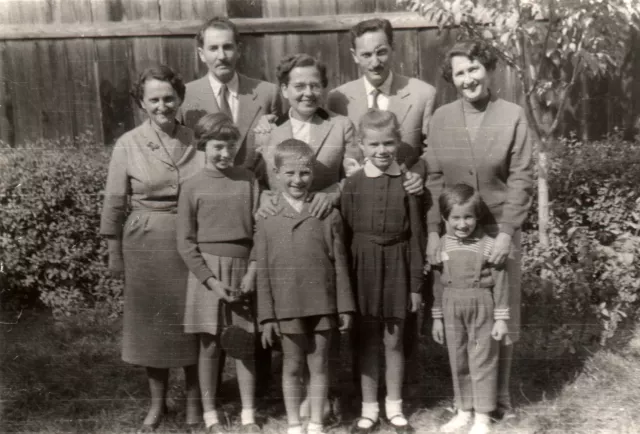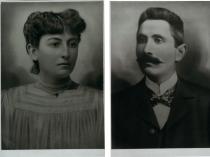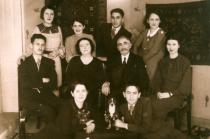The Struhl siblings with their families
This photo was taken in August 1959 in Marosvasarhely, in our courtyard. My husband, Andras Fazekas, took it. From left to right: Dora Struhl, Jeno Struhl, Andor Simon, Magda Fazekas - the Struhl siblings, Ilona Simon, my sister-in-law in the center and the children: Judit Incze, nee Fazekas, Istvan Simon, Vera Simon and Eva Frank, nee Fazekas. At that time we all lived in that house.
I was at a ball only once in my life, in January 1949, and this ball determined my fate. It was decided there whom I should marry. I met my husband there, and he was my husband for almost sixty years - the marriage lasted fifty-seven years. We got married in 1949, and in 1950 Juditka [Judit] was born, in 1955 Evike [Eva]. Juditka was the best child one could imagine. There was quite a big difference of age between the two children. I gave birth to Juditka when I was thirty. When we got married, my husband said that he wanted three children, but since my second child was born when I was already thirty-five, I was out of time, so we dropped the idea of a third child.
My husband was called up, and he was in the army for twenty months. During this period I let out the room to Sanyi [Sandor] Ausch, who is now the president of the Jewish community. In the meantime Sanyi Ausch got married and moved. My husband was still gone, and I didn't have any income, and I was pregnant. After the Ausch family left, I let it out to a young couple, he was a doctor and I also knew him.
During this time Dorika helped us. She didn't have any actual qualification in commerce, but she was an extremely clever, capable person. I wasn't as resourceful as my sisters, who opened a sewing workshop, and the others, the boys; I was the youngest, and I was spoiled too a little.
She didn't get married. She dedicated all her life, as she left school, to her family, to save my father's honor. When she took on this job at the public health institution, it wasn't easy, she had to go there early in the morning; most often she didn't take a bus, but walked all the way. I think the way there was three kilometers, and she walked in summer and in winter, when it was freezing. Then a ministerial act dissolved all the public health institutions in all Romania.
Her next job was at the Sanepid, she was chief accountant there. They elbowed her out of there. Then she was chief accountant at the Red Cross, where her boss was a vicious man. He gave her such a hard time that she developed heart problems. By the time she could retire, her health had already deteriorated. We were together to the very end in Marosvasarhely, she died in 1991 at the age of eighty-two. She is buried in the Jewish cemetery, and my brother Andor is buried there too.






















